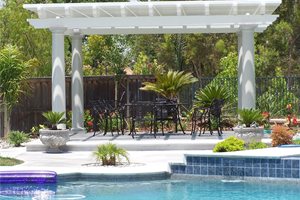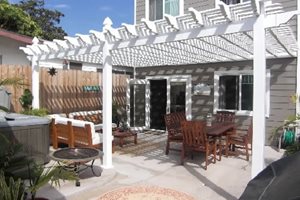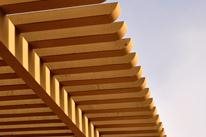Wood Pergolas
Designs and inspiration for wooden pergolasA wooden pergola can provide shade and shelter outdoors. Having a wood patio cover built in your yard will improve your property value and provide a place for friends and family to gather (see Creating the Perfect Outdoor Entertaining Space). Wood is a popular material for patio cover construction because it is affordable, easy to work with and allows for nearly limitless customization.
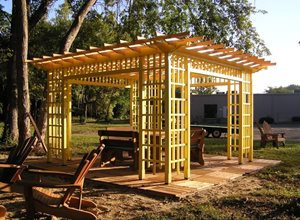
This freestanding wood patio cover was built
from a western red cedar kit. Baldwin Pergolas in Middletown, CT.
The majority of pergolas are constructed of wood, because it’s easy to adjust the size and style to fit your needs. You don’t need unusual tools to cut it, it’s widely available, and it can be painted, stained, or left natural to weather. However, the downside of using a natural material like wood is that it does need periodic sanding and re-painting, or staining, to continue looking its best.
Wood Types
When building a wooden patio cover there are many types of wood to choose from. The most important thing to consider is the outdoor durability of the wood you select. You'll want a type of wood that resists insect damage, rot, and other forms of weathering.
There are a number of types of wood appropriate for building a pergola:
- Ipe is a tropical hardwood that lasts well even in salty coastal conditions. It weathers to a silvery-brown and can be stained or left natural.
- Redwood is another attractive and long-lasting choice. “If someone wants a natural wood color, I use all-heart redwood,” says Alison Terry, a landscape architect in Fullerton, CA.
- Cedar is similar to all-heart redwood in that it withstands the elements effectively. The main difference is that cedar weathers quickly to a grayish color, while redwood retains its reddish-brown color a little longer. Cedar takes paint and stain particularly well.
- Pressure-treated wood is unattractive but cheap and long-lasting. It’s treated with a copper-based pesticide which repels insects and rot, but the treatment leaves little indentations along the surface of the wood which are visible even after painting or staining. “We’ll often wrap a pressure-treated post with 1” by 1” cedar,” says Ryan Aakre of Signature Landscapes Inc. in Fargo, ND. This allows you to save money while still enjoying the finished look of high-quality wood.
- Douglas fir is another inexpensive wood choice. “If you’re not concerned with longevity, you could use Doug fir,” says Terry. “Keep it maintained by painting regularly, inspecting for signs of insect damage or rot, and make sure the footings are installed correctly so it’s elevated off the ground,” she advises. “It can be moist, so when initially installing, the contractor may need to sand and paint it multiple times before it looks good.”
- Pro Tip: A pergola built of untreated wood is highly susceptible to wet and cold weather. Without routine maintenance seasonal damage is likely to occur.
One of the most common types of wood used for pergola construction is pressure-treated pine. Pressure-treated pine, the most affordable option, is rot and insect resistant. However, a preservative will need to be applied after construction to slow the process of weathering. Pressure-treated pine can be stained nearly any color you like.
Another type of wood that can be used to build a patio cover is cedar. Cedar naturally resists warping, cracking, insects and moisture rot. Because cedar is lightweight and easy to handle, but still very strong, it is often the preferred patio cover wood of professional carpenters. Additionally, cedar takes stains well and can be painted.
Other woods that can be used for building a patio cover are redwood, oak, cypress and teak. These wood types tend to be more expensive than pressure-treated pine and cedar.
If you choose wood for your pergola, Terry notes that you can use different types of wood, and stain them to match. Because different types of wood stain differently, you’ll need to stain each type of wood with a different color in order for them to look the same in the end. Paint companies such as Dunn-Edwards have experts on staff who can advise how to do this effectively.
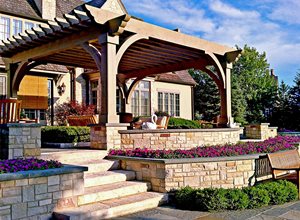
A custom wood patio cover can be built to
provide as much, or as little, shade as you like.
Romani Landscape Architecture.
Custom Wood Patio Covers
Another option is to hire a landscape contractor or carpenter to build you a custom wood patio cover. Going this route will allow you to completely customize your patio cover. Wood is an excellent material for custom designs because it can easily be cut on site to meet your size requirements. Furthermore, a custom patio cover can be constructed to let as little or as much light through as you desire.
A wooden patio cover can be finished in a number of ways. First, wood allows for staining or painting in whatever color you like. Second, decorative cuts can be made at the end of each piece of lumber, giving your patio cover a unique, finished appearance. Third, an experienced patio cover craftsman can incorporate wood benches, planters and lighting into the design.
Wood Patio Cover Kits
If you are looking for a quick patio cover option that doesn't require hiring someone to draw up a plan, then a wood patio cover kit is the answer. A wooden patio cover kit comes with all the lumber cut to size, the required hardware and detailed assembly instructions for your contractor to follow. Expect to pay between $3,000 and $6,500 for a wood patio cover kit; you'll have to pay for installation separately.
Wooden pergola kits are available in a variety of sizes and styles. You can choose between attached and detached models, as well as solid and lattice roofs. Make sure to measure the area in which you plan to install the patio cover before ordering.
Two companies that offer wooden patio cover kits are Baldwin Pergolas and Backyard America.
Maintenance
A wood patio cover will require annual maintenance. It will need to be treated regularly to keep termites at bay and protect it from weather damage. A wooden patio cover will also need to be repainted frequently to keep up its original appearance. If not maintained properly, the wood could rot and deteriorate quickly making it necessary to replace the entire patio cover. However, if properly cared for you can enjoy your wood patio cover for many years.
Related Reading:
 Backyards
Backyards
 Front Yards
Front Yards
